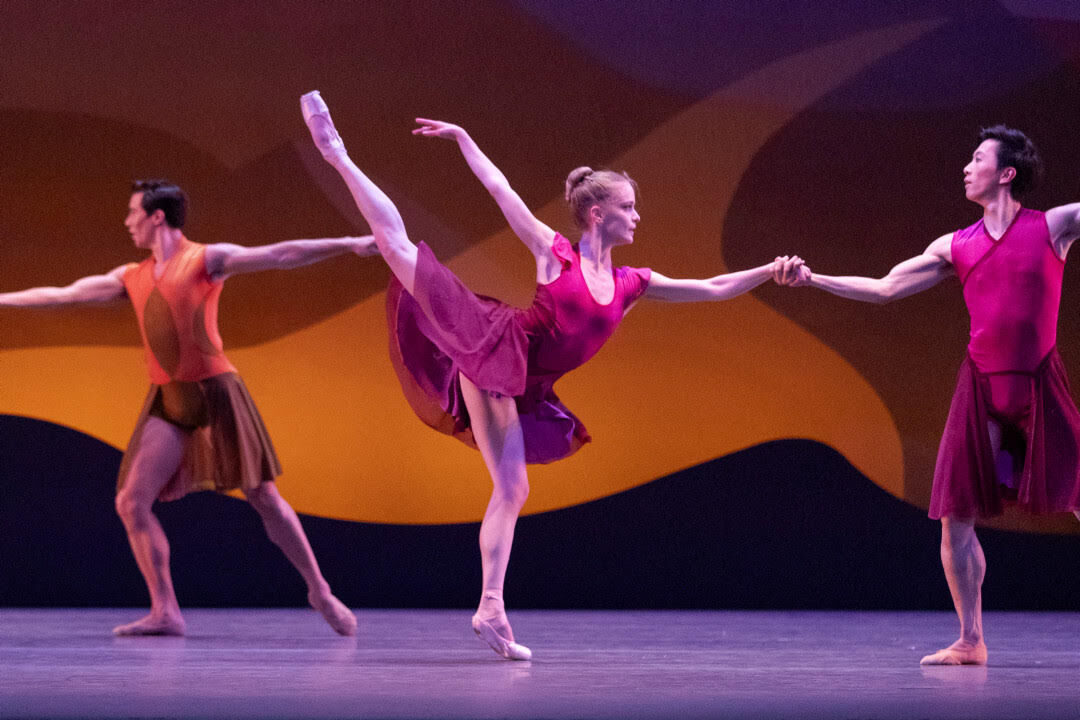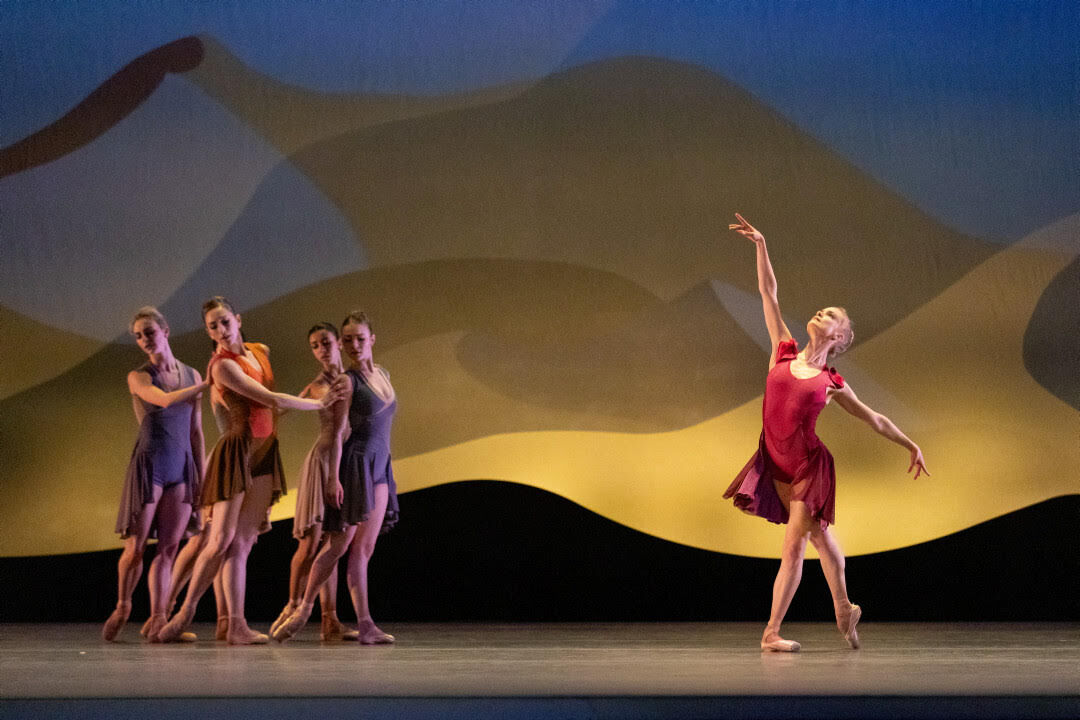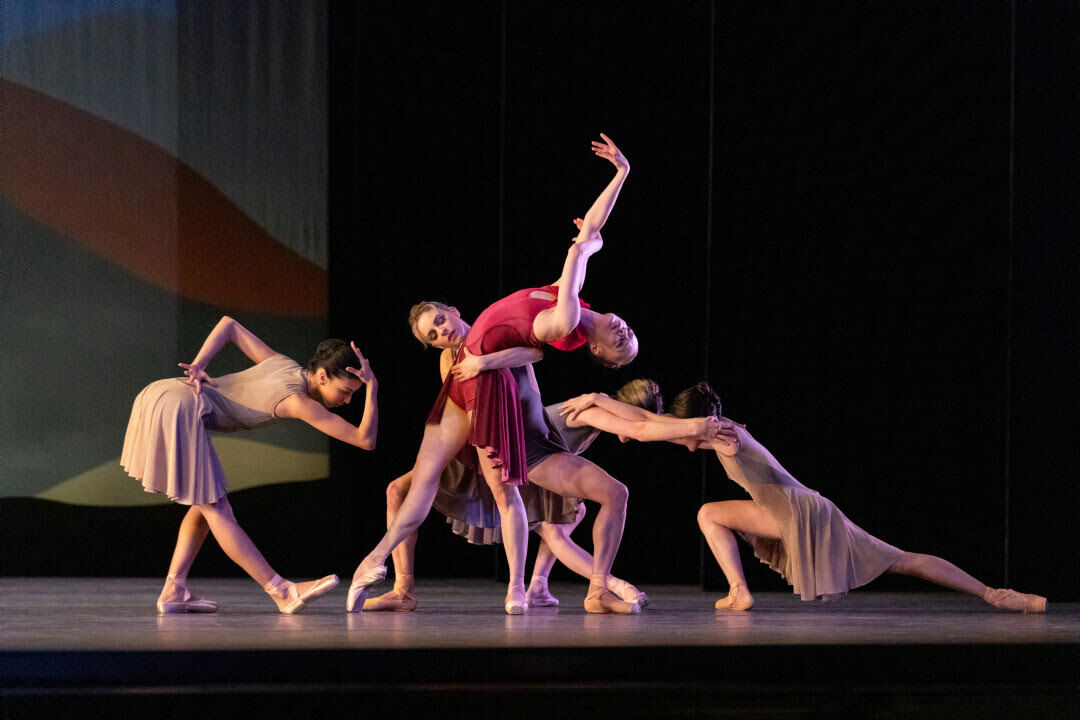
Photo by Reneff-Olson Production, courtesy of San Francisco Ballet
Fashion Design Chair Katrin Schnabl’s Designs Shine at the San Francisco Ballet
“Dance, when you’re broken open / Dance, if you’ve torn the bandage off / Dance in the middle of the fighting / Dance in your blood / Dance, when you’re perfectly free.” This Rumi quote appears in the lyrics for Gateway to the Sun, a new dance performance staged for the San Francisco Ballet’s Next@90 Festival. When School of the Art Institute of Chicago Fashion Design Chair and Professor Katrin Schnabl created the costumes and sets for the performance, the challenge was merging modern ballet with the words of the ancient Persian poet.
Designing for ballet means putting motion first: Schnabl’s costumes take their cues from medieval Persia while highlighting the flow of the dancers. The set itself lower and raises, lending a depth of dimension to the stage beyond the performers.
This approach to fashion as a whole—considering both the movement of garments and the bodies that wear them—is a staple of SAIC’s Fashion Design program. This summer, Students can explore flexibility in fashion in Schnabl’s three-week intensive course, Elastic Limbs, from July 29–August 16. Here, she discusses her design inspiration, collaborative approach, and why designing for ballet is different from other fashion design challenges.

Photo by Lindsay Thomas, courtesy of San Francisco Ballet
Photo by Reneff-Olson Production, courtesy of San Francisco Ballet
How would you describe the set for someone who hasn’t seen the performance?
The scenes evoke landscapes: dunes, waves, the desert, hilly mountains, a series of soft curving lines that intersect and overlap. The format of the set takes its inspiration from my dimensional paintings, which are sheer tinted scrolls I created during pandemic. By scrolling the anterior against the posterior section, the painting changes in a kaleidoscopic way, allowing there to be a progression, or change, throughout the work.
I have previously collaborated with Nicolas Blanc, the choreographer for Gateway to the Sun, on a work for the Joffrey Ballet titled Beyond the Shores. Nicolas was invited to choreograph a new work for San Francisco Ballet's Next@90 festival, and brought me on board as a collaborator for costumes and set. We talked about how this scrolling concept from my artworks could apply to the stage, and we proposed it to the San Francisco Ballet team. We ultimately created a hybrid between my concept and the more traditional painted scenic backdrops.

Photo by Lindsay Thomas, courtesy of San Francisco Ballet
Photo by Reneff-Olson Production, courtesy of San Francisco Ballet
What inspired your costume designs?
The score by Anna Clyne was inspired by the Rumi poem Dance, and in turn became the point of departure for choreographer Nic Blanc, in a creative dialogue across time and space. Rumi's 13th century Persia provided a starting point for the costume direction, and we researched the architecture, costumes, and customs of medieval Persia to capture a feeling that would compliment the timeless poem and contemporary classical music. From there, we worked with the coloring from images of the historic caftans, and drew from it very rich earthy tones for the main couples, metallic colors for the corps de ballet, and pale blue for the main character, the poet. We studied the detailing and shapes of the caftans and robes to create abstractions of sleeveless coats with cut-aways that still moved lusciously and showed the arms and legs. We were interested in an ungendered quality for the costume, and kept the main shape consistent across the dancers.
How did you collaborate with the San Francisco Ballet team?
I worked very closely with the choreographer throughout. A lot of the collaboration with the teams in San Francisco took place online. When I traveled to San Francisco to see the final rehearsal, I met the company, the technical director, lighting designer, and wardrobe supervisor, all of whom worked closely with us to workshop the main concepts and detailed ideas early and often. There is a lot of creative excitement and expertise in those spaces, and everything serves the whole production. We decided that their shop would create the stage details in-house based on my sketches and specifications, and the costumes would be created in my studio in Chicago.
Most of my studio team are alumni from our fashion program, and they are incredible! My studio associate flew in for fittings, while I attended via Zoom from Chicago, and then we completed the costumes here and sent them to San Francisco.
Prior to the premiere, I flew in with two associates to be on hand for any last-minute adjustments. My jaw dropped when I saw the set for the first time live. it was at once exactly how we had modeled it, and much more luminous and breathtaking than a model can ever be.

Photo by Lindsay Thomas, courtesy of San Francisco Ballet
Photo by Reneff-Olson Production, courtesy of San Francisco Ballet
How is designing for ballet unique?
Designing for dance, and ballet in particular, is supporting and responding to highly sensitive and trained bodies doing their most phenomenal best. Everything is about setting up the potential for performance excellence for the dancers. Design has to support the specifics of the movement up close, and enhance the legibility of the dance from a distance. Dancers are very clear. They give great feedback and will tell you what feels loose or irritating. There is ingenious problem-solving that is quite unlike the fashion industry, for example. The garment has to merge with the dancers, has to become them, quite literally an extension of them, to invite that performance magic.
